Analysis of Cultural Differences and Asylum Seekers in Australia
VerifiedAdded on 2022/08/20
|8
|2076
|277
Essay
AI Summary
This essay delves into the multifaceted issue of cultural differences and their profound impact on asylum seekers in Australia. It meticulously examines the ways in which cultural values influence the treatment and perception of refugees, highlighting the role of media in shaping public opinion and political discourse. The essay explores how different countries, including Australia, grapple with these differences, often leading to biased approaches and the marginalization of asylum seekers. It analyzes the historical context, political debates, and policy responses surrounding asylum seekers in Australia, including the use of terms like 'boat arrivals' and the influence of post-structuralist theories. Furthermore, it investigates the dominant and marginalized views presented in the media, the impact of these discourses on Australian beliefs, and the ethical considerations of providing refuge. The essay concludes by emphasizing the importance of unbiased policies, humane treatment, and the media's role in addressing challenges related to asylum seekers while promoting cultural learning and collaboration.
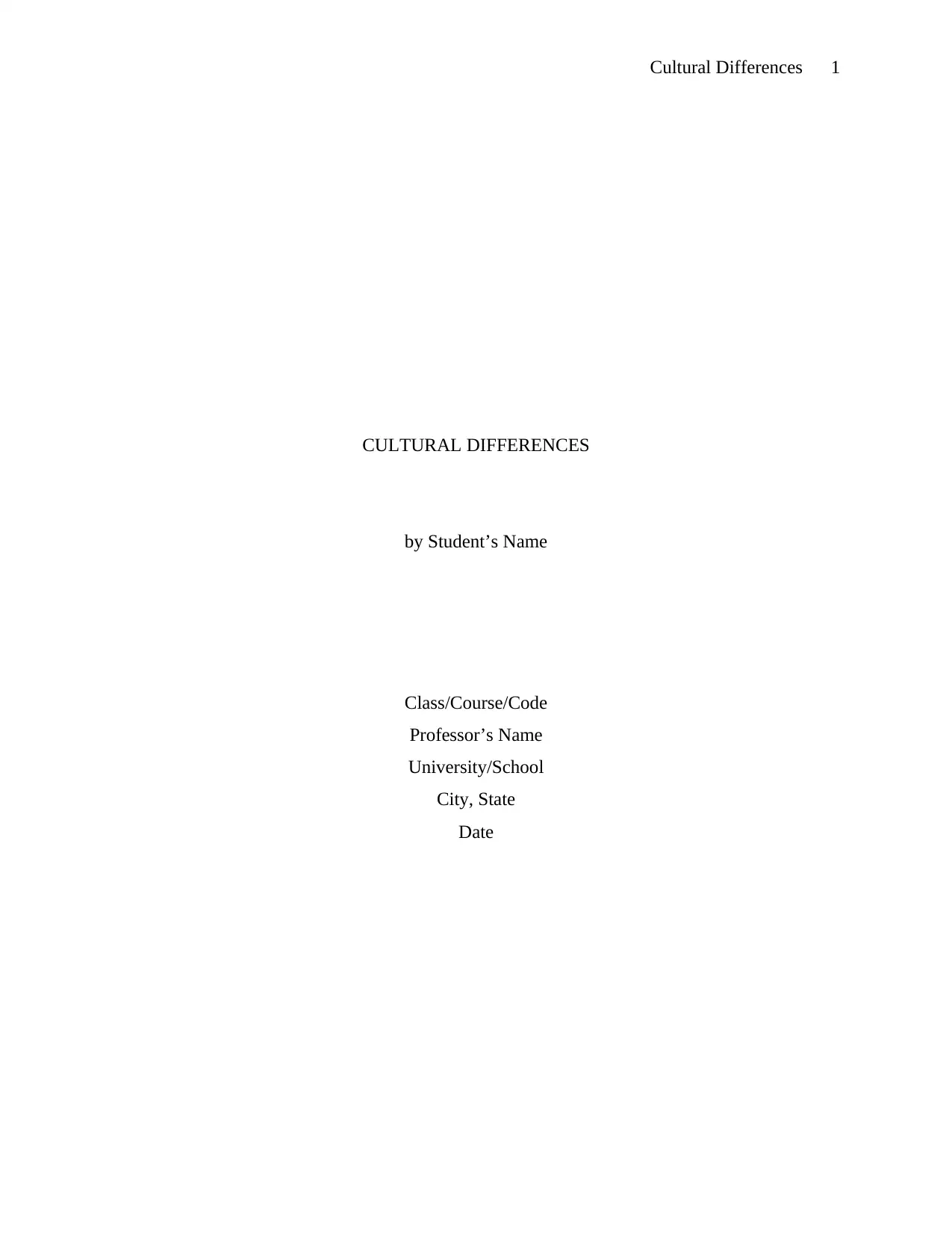
Cultural Differences 1
CULTURAL DIFFERENCES
by Student’s Name
Class/Course/Code
Professor’s Name
University/School
City, State
Date
CULTURAL DIFFERENCES
by Student’s Name
Class/Course/Code
Professor’s Name
University/School
City, State
Date
Paraphrase This Document
Need a fresh take? Get an instant paraphrase of this document with our AI Paraphraser
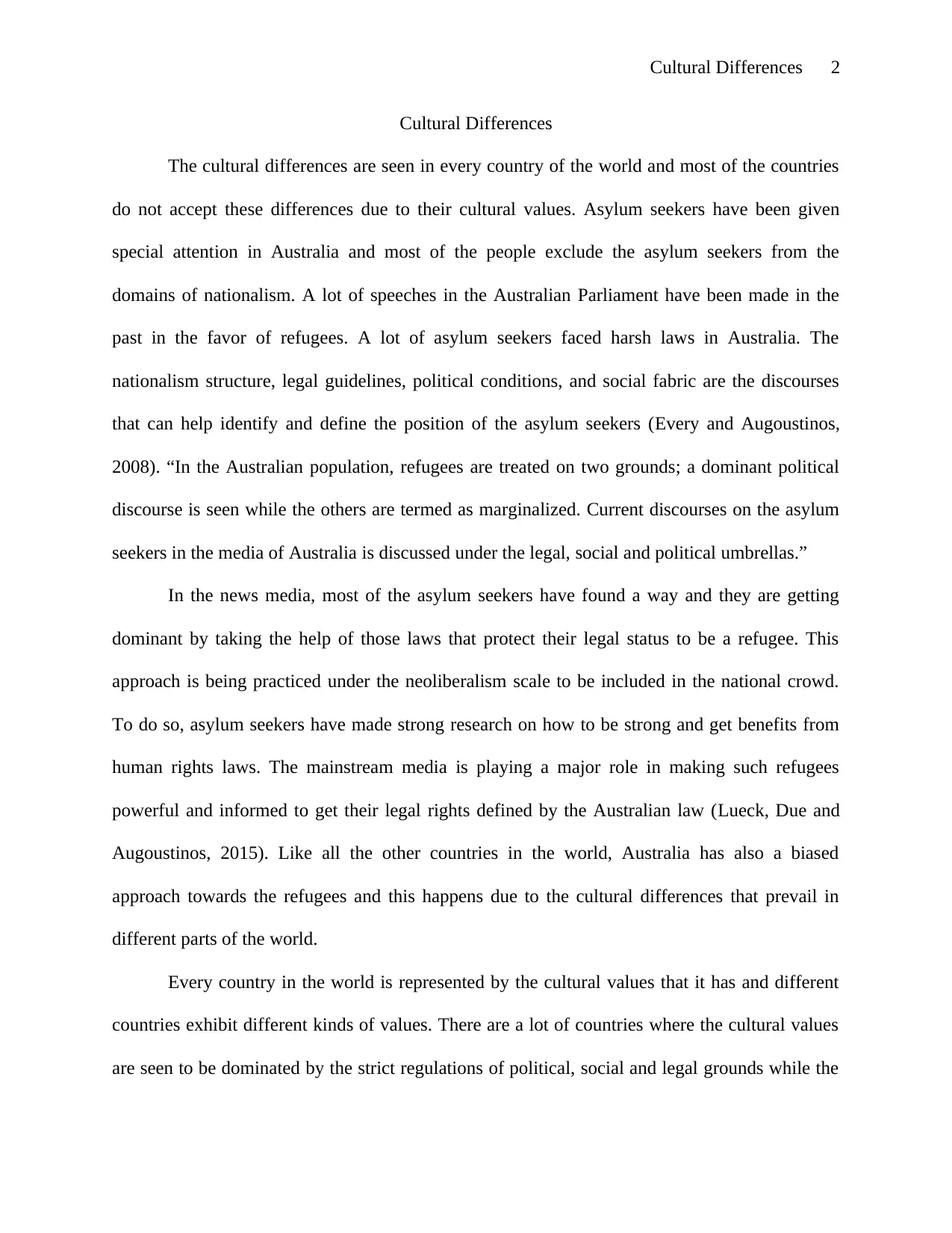
Cultural Differences 2
Cultural Differences
The cultural differences are seen in every country of the world and most of the countries
do not accept these differences due to their cultural values. Asylum seekers have been given
special attention in Australia and most of the people exclude the asylum seekers from the
domains of nationalism. A lot of speeches in the Australian Parliament have been made in the
past in the favor of refugees. A lot of asylum seekers faced harsh laws in Australia. The
nationalism structure, legal guidelines, political conditions, and social fabric are the discourses
that can help identify and define the position of the asylum seekers (Every and Augoustinos,
2008). “In the Australian population, refugees are treated on two grounds; a dominant political
discourse is seen while the others are termed as marginalized. Current discourses on the asylum
seekers in the media of Australia is discussed under the legal, social and political umbrellas.”
In the news media, most of the asylum seekers have found a way and they are getting
dominant by taking the help of those laws that protect their legal status to be a refugee. This
approach is being practiced under the neoliberalism scale to be included in the national crowd.
To do so, asylum seekers have made strong research on how to be strong and get benefits from
human rights laws. The mainstream media is playing a major role in making such refugees
powerful and informed to get their legal rights defined by the Australian law (Lueck, Due and
Augoustinos, 2015). Like all the other countries in the world, Australia has also a biased
approach towards the refugees and this happens due to the cultural differences that prevail in
different parts of the world.
Every country in the world is represented by the cultural values that it has and different
countries exhibit different kinds of values. There are a lot of countries where the cultural values
are seen to be dominated by the strict regulations of political, social and legal grounds while the
Cultural Differences
The cultural differences are seen in every country of the world and most of the countries
do not accept these differences due to their cultural values. Asylum seekers have been given
special attention in Australia and most of the people exclude the asylum seekers from the
domains of nationalism. A lot of speeches in the Australian Parliament have been made in the
past in the favor of refugees. A lot of asylum seekers faced harsh laws in Australia. The
nationalism structure, legal guidelines, political conditions, and social fabric are the discourses
that can help identify and define the position of the asylum seekers (Every and Augoustinos,
2008). “In the Australian population, refugees are treated on two grounds; a dominant political
discourse is seen while the others are termed as marginalized. Current discourses on the asylum
seekers in the media of Australia is discussed under the legal, social and political umbrellas.”
In the news media, most of the asylum seekers have found a way and they are getting
dominant by taking the help of those laws that protect their legal status to be a refugee. This
approach is being practiced under the neoliberalism scale to be included in the national crowd.
To do so, asylum seekers have made strong research on how to be strong and get benefits from
human rights laws. The mainstream media is playing a major role in making such refugees
powerful and informed to get their legal rights defined by the Australian law (Lueck, Due and
Augoustinos, 2015). Like all the other countries in the world, Australia has also a biased
approach towards the refugees and this happens due to the cultural differences that prevail in
different parts of the world.
Every country in the world is represented by the cultural values that it has and different
countries exhibit different kinds of values. There are a lot of countries where the cultural values
are seen to be dominated by the strict regulations of political, social and legal grounds while the
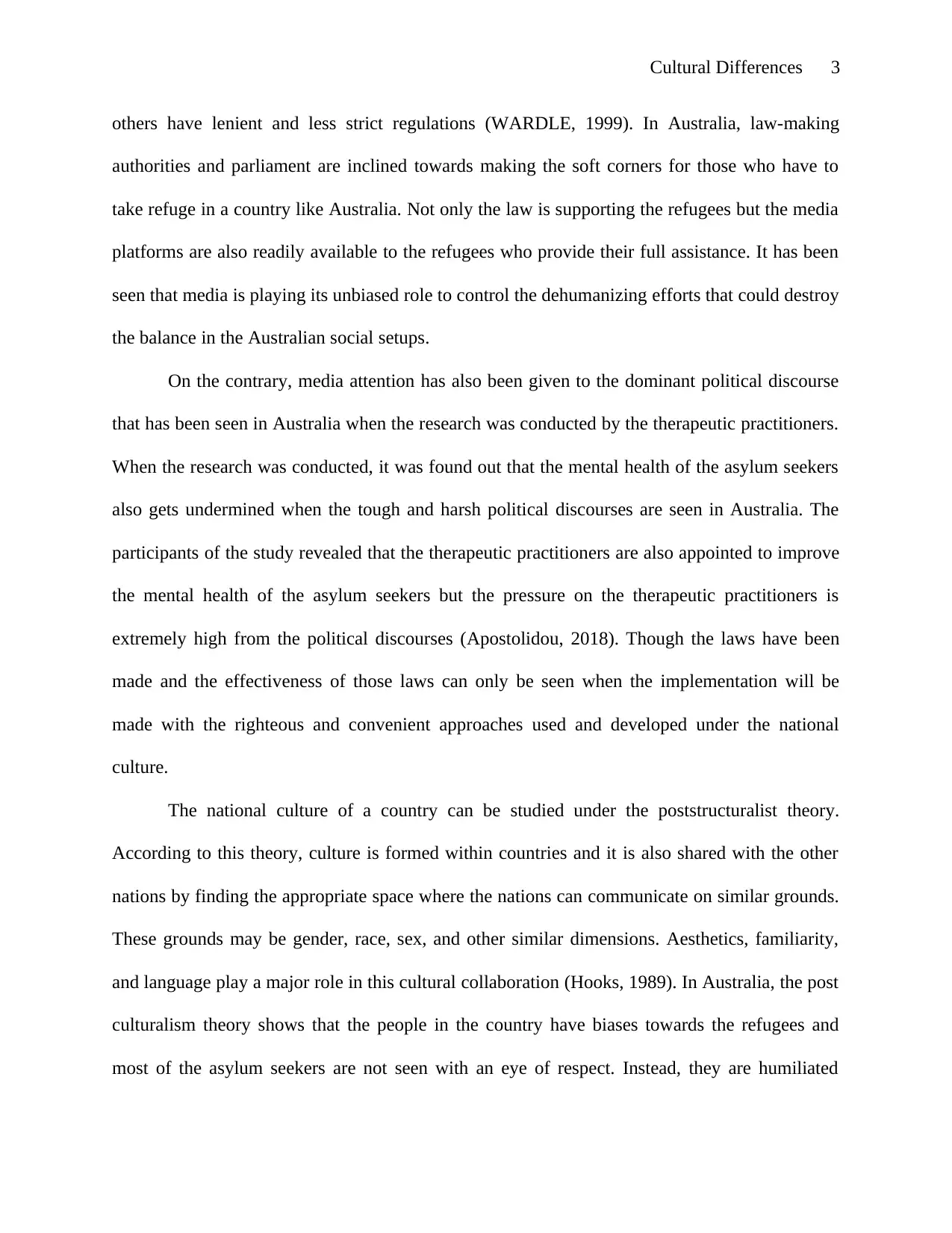
Cultural Differences 3
others have lenient and less strict regulations (WARDLE, 1999). In Australia, law-making
authorities and parliament are inclined towards making the soft corners for those who have to
take refuge in a country like Australia. Not only the law is supporting the refugees but the media
platforms are also readily available to the refugees who provide their full assistance. It has been
seen that media is playing its unbiased role to control the dehumanizing efforts that could destroy
the balance in the Australian social setups.
On the contrary, media attention has also been given to the dominant political discourse
that has been seen in Australia when the research was conducted by the therapeutic practitioners.
When the research was conducted, it was found out that the mental health of the asylum seekers
also gets undermined when the tough and harsh political discourses are seen in Australia. The
participants of the study revealed that the therapeutic practitioners are also appointed to improve
the mental health of the asylum seekers but the pressure on the therapeutic practitioners is
extremely high from the political discourses (Apostolidou, 2018). Though the laws have been
made and the effectiveness of those laws can only be seen when the implementation will be
made with the righteous and convenient approaches used and developed under the national
culture.
The national culture of a country can be studied under the poststructuralist theory.
According to this theory, culture is formed within countries and it is also shared with the other
nations by finding the appropriate space where the nations can communicate on similar grounds.
These grounds may be gender, race, sex, and other similar dimensions. Aesthetics, familiarity,
and language play a major role in this cultural collaboration (Hooks, 1989). In Australia, the post
culturalism theory shows that the people in the country have biases towards the refugees and
most of the asylum seekers are not seen with an eye of respect. Instead, they are humiliated
others have lenient and less strict regulations (WARDLE, 1999). In Australia, law-making
authorities and parliament are inclined towards making the soft corners for those who have to
take refuge in a country like Australia. Not only the law is supporting the refugees but the media
platforms are also readily available to the refugees who provide their full assistance. It has been
seen that media is playing its unbiased role to control the dehumanizing efforts that could destroy
the balance in the Australian social setups.
On the contrary, media attention has also been given to the dominant political discourse
that has been seen in Australia when the research was conducted by the therapeutic practitioners.
When the research was conducted, it was found out that the mental health of the asylum seekers
also gets undermined when the tough and harsh political discourses are seen in Australia. The
participants of the study revealed that the therapeutic practitioners are also appointed to improve
the mental health of the asylum seekers but the pressure on the therapeutic practitioners is
extremely high from the political discourses (Apostolidou, 2018). Though the laws have been
made and the effectiveness of those laws can only be seen when the implementation will be
made with the righteous and convenient approaches used and developed under the national
culture.
The national culture of a country can be studied under the poststructuralist theory.
According to this theory, culture is formed within countries and it is also shared with the other
nations by finding the appropriate space where the nations can communicate on similar grounds.
These grounds may be gender, race, sex, and other similar dimensions. Aesthetics, familiarity,
and language play a major role in this cultural collaboration (Hooks, 1989). In Australia, the post
culturalism theory shows that the people in the country have biases towards the refugees and
most of the asylum seekers are not seen with an eye of respect. Instead, they are humiliated
⊘ This is a preview!⊘
Do you want full access?
Subscribe today to unlock all pages.

Trusted by 1+ million students worldwide
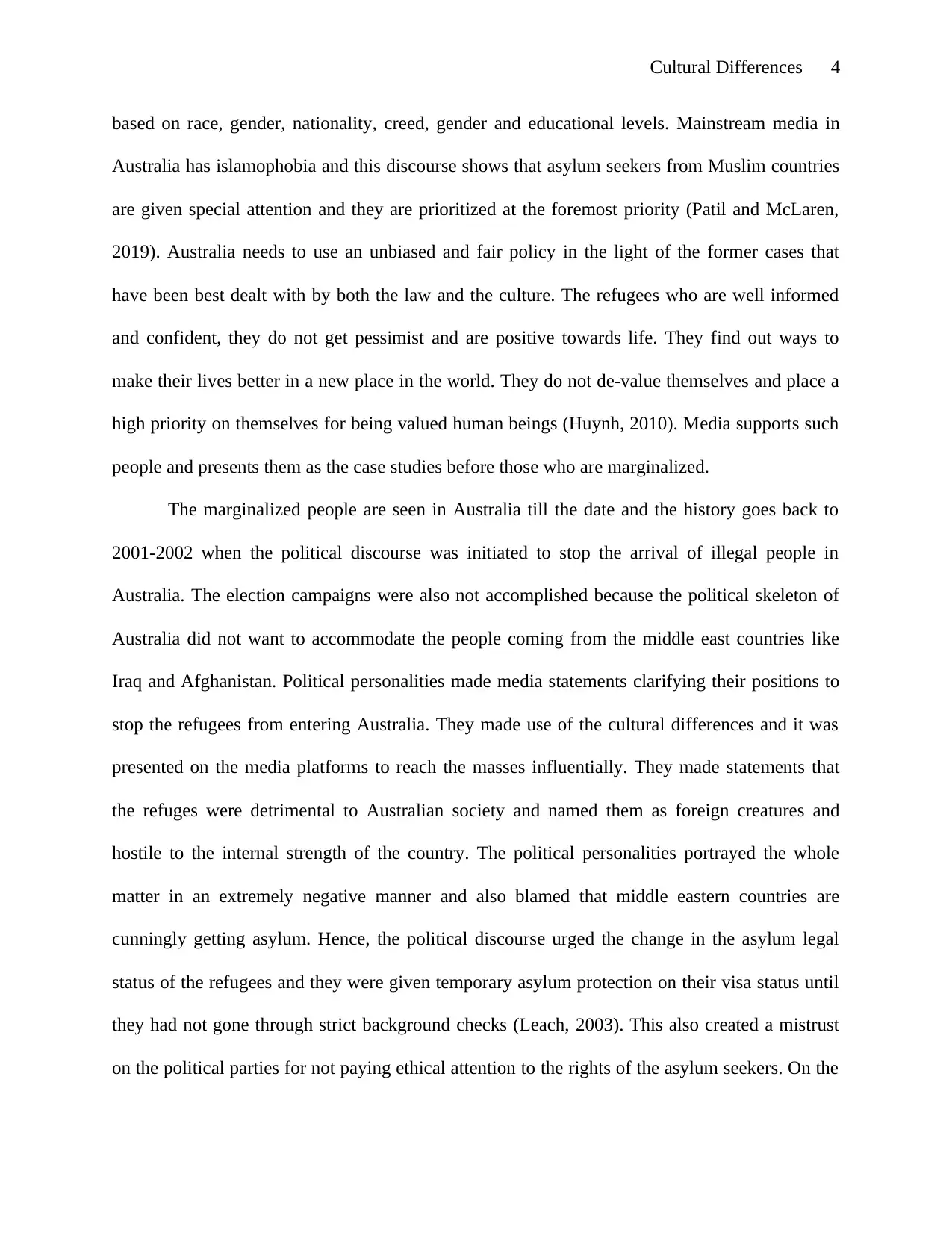
Cultural Differences 4
based on race, gender, nationality, creed, gender and educational levels. Mainstream media in
Australia has islamophobia and this discourse shows that asylum seekers from Muslim countries
are given special attention and they are prioritized at the foremost priority (Patil and McLaren,
2019). Australia needs to use an unbiased and fair policy in the light of the former cases that
have been best dealt with by both the law and the culture. The refugees who are well informed
and confident, they do not get pessimist and are positive towards life. They find out ways to
make their lives better in a new place in the world. They do not de-value themselves and place a
high priority on themselves for being valued human beings (Huynh, 2010). Media supports such
people and presents them as the case studies before those who are marginalized.
The marginalized people are seen in Australia till the date and the history goes back to
2001-2002 when the political discourse was initiated to stop the arrival of illegal people in
Australia. The election campaigns were also not accomplished because the political skeleton of
Australia did not want to accommodate the people coming from the middle east countries like
Iraq and Afghanistan. Political personalities made media statements clarifying their positions to
stop the refugees from entering Australia. They made use of the cultural differences and it was
presented on the media platforms to reach the masses influentially. They made statements that
the refuges were detrimental to Australian society and named them as foreign creatures and
hostile to the internal strength of the country. The political personalities portrayed the whole
matter in an extremely negative manner and also blamed that middle eastern countries are
cunningly getting asylum. Hence, the political discourse urged the change in the asylum legal
status of the refugees and they were given temporary asylum protection on their visa status until
they had not gone through strict background checks (Leach, 2003). This also created a mistrust
on the political parties for not paying ethical attention to the rights of the asylum seekers. On the
based on race, gender, nationality, creed, gender and educational levels. Mainstream media in
Australia has islamophobia and this discourse shows that asylum seekers from Muslim countries
are given special attention and they are prioritized at the foremost priority (Patil and McLaren,
2019). Australia needs to use an unbiased and fair policy in the light of the former cases that
have been best dealt with by both the law and the culture. The refugees who are well informed
and confident, they do not get pessimist and are positive towards life. They find out ways to
make their lives better in a new place in the world. They do not de-value themselves and place a
high priority on themselves for being valued human beings (Huynh, 2010). Media supports such
people and presents them as the case studies before those who are marginalized.
The marginalized people are seen in Australia till the date and the history goes back to
2001-2002 when the political discourse was initiated to stop the arrival of illegal people in
Australia. The election campaigns were also not accomplished because the political skeleton of
Australia did not want to accommodate the people coming from the middle east countries like
Iraq and Afghanistan. Political personalities made media statements clarifying their positions to
stop the refugees from entering Australia. They made use of the cultural differences and it was
presented on the media platforms to reach the masses influentially. They made statements that
the refuges were detrimental to Australian society and named them as foreign creatures and
hostile to the internal strength of the country. The political personalities portrayed the whole
matter in an extremely negative manner and also blamed that middle eastern countries are
cunningly getting asylum. Hence, the political discourse urged the change in the asylum legal
status of the refugees and they were given temporary asylum protection on their visa status until
they had not gone through strict background checks (Leach, 2003). This also created a mistrust
on the political parties for not paying ethical attention to the rights of the asylum seekers. On the
Paraphrase This Document
Need a fresh take? Get an instant paraphrase of this document with our AI Paraphraser
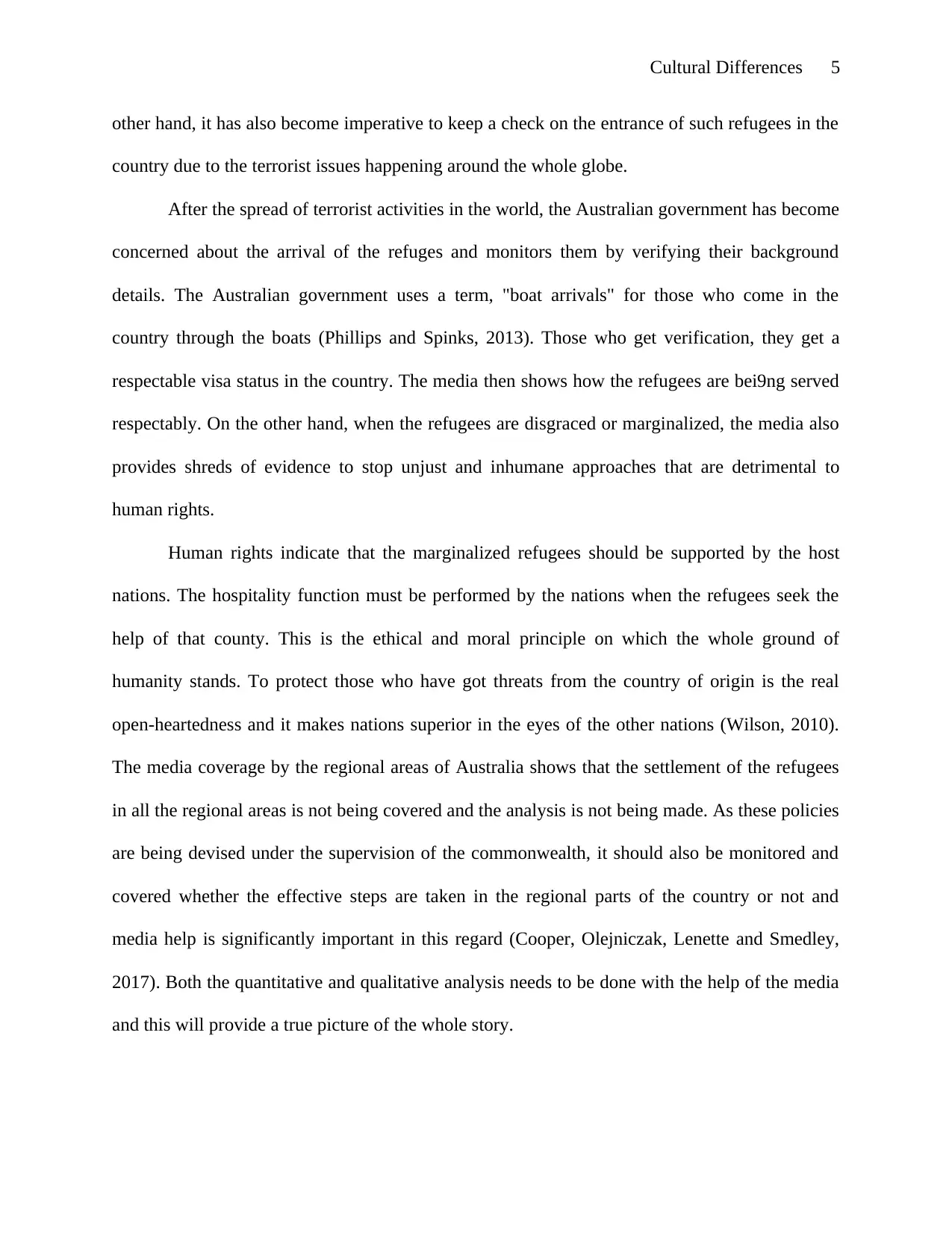
Cultural Differences 5
other hand, it has also become imperative to keep a check on the entrance of such refugees in the
country due to the terrorist issues happening around the whole globe.
After the spread of terrorist activities in the world, the Australian government has become
concerned about the arrival of the refuges and monitors them by verifying their background
details. The Australian government uses a term, "boat arrivals" for those who come in the
country through the boats (Phillips and Spinks, 2013). Those who get verification, they get a
respectable visa status in the country. The media then shows how the refugees are bei9ng served
respectably. On the other hand, when the refugees are disgraced or marginalized, the media also
provides shreds of evidence to stop unjust and inhumane approaches that are detrimental to
human rights.
Human rights indicate that the marginalized refugees should be supported by the host
nations. The hospitality function must be performed by the nations when the refugees seek the
help of that county. This is the ethical and moral principle on which the whole ground of
humanity stands. To protect those who have got threats from the country of origin is the real
open-heartedness and it makes nations superior in the eyes of the other nations (Wilson, 2010).
The media coverage by the regional areas of Australia shows that the settlement of the refugees
in all the regional areas is not being covered and the analysis is not being made. As these policies
are being devised under the supervision of the commonwealth, it should also be monitored and
covered whether the effective steps are taken in the regional parts of the country or not and
media help is significantly important in this regard (Cooper, Olejniczak, Lenette and Smedley,
2017). Both the quantitative and qualitative analysis needs to be done with the help of the media
and this will provide a true picture of the whole story.
other hand, it has also become imperative to keep a check on the entrance of such refugees in the
country due to the terrorist issues happening around the whole globe.
After the spread of terrorist activities in the world, the Australian government has become
concerned about the arrival of the refuges and monitors them by verifying their background
details. The Australian government uses a term, "boat arrivals" for those who come in the
country through the boats (Phillips and Spinks, 2013). Those who get verification, they get a
respectable visa status in the country. The media then shows how the refugees are bei9ng served
respectably. On the other hand, when the refugees are disgraced or marginalized, the media also
provides shreds of evidence to stop unjust and inhumane approaches that are detrimental to
human rights.
Human rights indicate that the marginalized refugees should be supported by the host
nations. The hospitality function must be performed by the nations when the refugees seek the
help of that county. This is the ethical and moral principle on which the whole ground of
humanity stands. To protect those who have got threats from the country of origin is the real
open-heartedness and it makes nations superior in the eyes of the other nations (Wilson, 2010).
The media coverage by the regional areas of Australia shows that the settlement of the refugees
in all the regional areas is not being covered and the analysis is not being made. As these policies
are being devised under the supervision of the commonwealth, it should also be monitored and
covered whether the effective steps are taken in the regional parts of the country or not and
media help is significantly important in this regard (Cooper, Olejniczak, Lenette and Smedley,
2017). Both the quantitative and qualitative analysis needs to be done with the help of the media
and this will provide a true picture of the whole story.
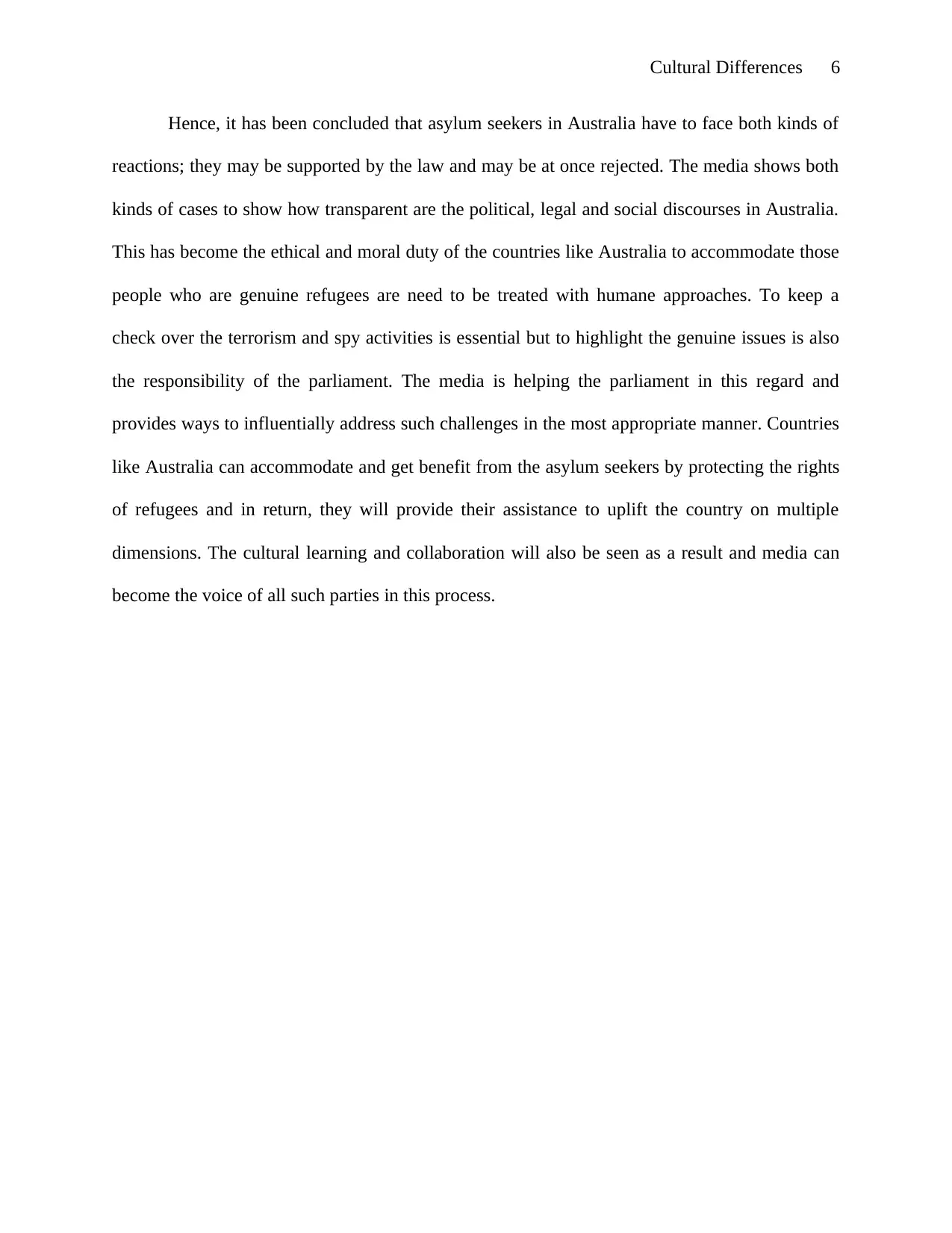
Cultural Differences 6
Hence, it has been concluded that asylum seekers in Australia have to face both kinds of
reactions; they may be supported by the law and may be at once rejected. The media shows both
kinds of cases to show how transparent are the political, legal and social discourses in Australia.
This has become the ethical and moral duty of the countries like Australia to accommodate those
people who are genuine refugees are need to be treated with humane approaches. To keep a
check over the terrorism and spy activities is essential but to highlight the genuine issues is also
the responsibility of the parliament. The media is helping the parliament in this regard and
provides ways to influentially address such challenges in the most appropriate manner. Countries
like Australia can accommodate and get benefit from the asylum seekers by protecting the rights
of refugees and in return, they will provide their assistance to uplift the country on multiple
dimensions. The cultural learning and collaboration will also be seen as a result and media can
become the voice of all such parties in this process.
Hence, it has been concluded that asylum seekers in Australia have to face both kinds of
reactions; they may be supported by the law and may be at once rejected. The media shows both
kinds of cases to show how transparent are the political, legal and social discourses in Australia.
This has become the ethical and moral duty of the countries like Australia to accommodate those
people who are genuine refugees are need to be treated with humane approaches. To keep a
check over the terrorism and spy activities is essential but to highlight the genuine issues is also
the responsibility of the parliament. The media is helping the parliament in this regard and
provides ways to influentially address such challenges in the most appropriate manner. Countries
like Australia can accommodate and get benefit from the asylum seekers by protecting the rights
of refugees and in return, they will provide their assistance to uplift the country on multiple
dimensions. The cultural learning and collaboration will also be seen as a result and media can
become the voice of all such parties in this process.
⊘ This is a preview!⊘
Do you want full access?
Subscribe today to unlock all pages.

Trusted by 1+ million students worldwide
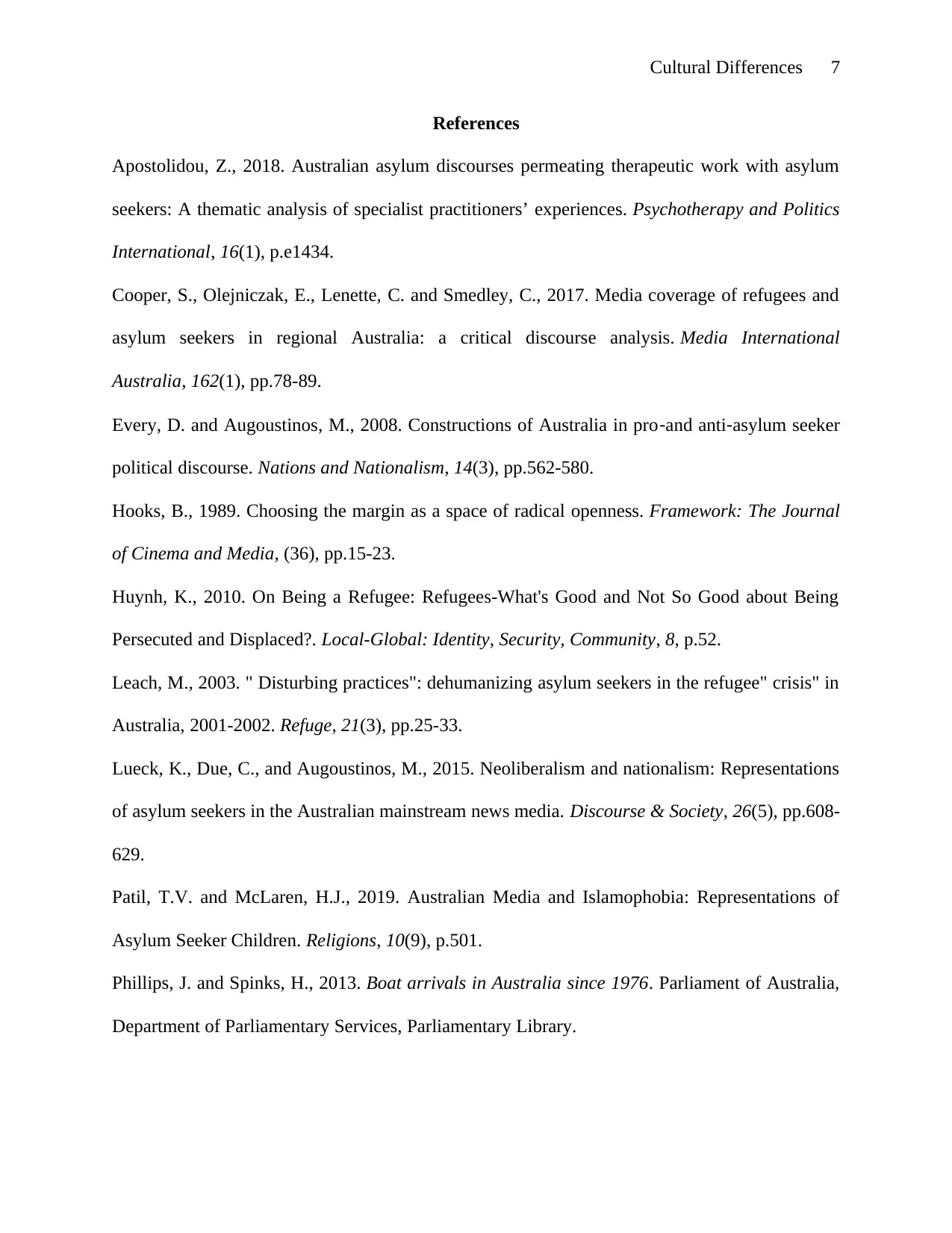
Cultural Differences 7
References
Apostolidou, Z., 2018. Australian asylum discourses permeating therapeutic work with asylum
seekers: A thematic analysis of specialist practitioners’ experiences. Psychotherapy and Politics
International, 16(1), p.e1434.
Cooper, S., Olejniczak, E., Lenette, C. and Smedley, C., 2017. Media coverage of refugees and
asylum seekers in regional Australia: a critical discourse analysis. Media International
Australia, 162(1), pp.78-89.
Every, D. and Augoustinos, M., 2008. Constructions of Australia in pro‐and anti‐asylum seeker
political discourse. Nations and Nationalism, 14(3), pp.562-580.
Hooks, B., 1989. Choosing the margin as a space of radical openness. Framework: The Journal
of Cinema and Media, (36), pp.15-23.
Huynh, K., 2010. On Being a Refugee: Refugees-What's Good and Not So Good about Being
Persecuted and Displaced?. Local-Global: Identity, Security, Community, 8, p.52.
Leach, M., 2003. " Disturbing practices": dehumanizing asylum seekers in the refugee" crisis" in
Australia, 2001-2002. Refuge, 21(3), pp.25-33.
Lueck, K., Due, C., and Augoustinos, M., 2015. Neoliberalism and nationalism: Representations
of asylum seekers in the Australian mainstream news media. Discourse & Society, 26(5), pp.608-
629.
Patil, T.V. and McLaren, H.J., 2019. Australian Media and Islamophobia: Representations of
Asylum Seeker Children. Religions, 10(9), p.501.
Phillips, J. and Spinks, H., 2013. Boat arrivals in Australia since 1976. Parliament of Australia,
Department of Parliamentary Services, Parliamentary Library.
References
Apostolidou, Z., 2018. Australian asylum discourses permeating therapeutic work with asylum
seekers: A thematic analysis of specialist practitioners’ experiences. Psychotherapy and Politics
International, 16(1), p.e1434.
Cooper, S., Olejniczak, E., Lenette, C. and Smedley, C., 2017. Media coverage of refugees and
asylum seekers in regional Australia: a critical discourse analysis. Media International
Australia, 162(1), pp.78-89.
Every, D. and Augoustinos, M., 2008. Constructions of Australia in pro‐and anti‐asylum seeker
political discourse. Nations and Nationalism, 14(3), pp.562-580.
Hooks, B., 1989. Choosing the margin as a space of radical openness. Framework: The Journal
of Cinema and Media, (36), pp.15-23.
Huynh, K., 2010. On Being a Refugee: Refugees-What's Good and Not So Good about Being
Persecuted and Displaced?. Local-Global: Identity, Security, Community, 8, p.52.
Leach, M., 2003. " Disturbing practices": dehumanizing asylum seekers in the refugee" crisis" in
Australia, 2001-2002. Refuge, 21(3), pp.25-33.
Lueck, K., Due, C., and Augoustinos, M., 2015. Neoliberalism and nationalism: Representations
of asylum seekers in the Australian mainstream news media. Discourse & Society, 26(5), pp.608-
629.
Patil, T.V. and McLaren, H.J., 2019. Australian Media and Islamophobia: Representations of
Asylum Seeker Children. Religions, 10(9), p.501.
Phillips, J. and Spinks, H., 2013. Boat arrivals in Australia since 1976. Parliament of Australia,
Department of Parliamentary Services, Parliamentary Library.
Paraphrase This Document
Need a fresh take? Get an instant paraphrase of this document with our AI Paraphraser
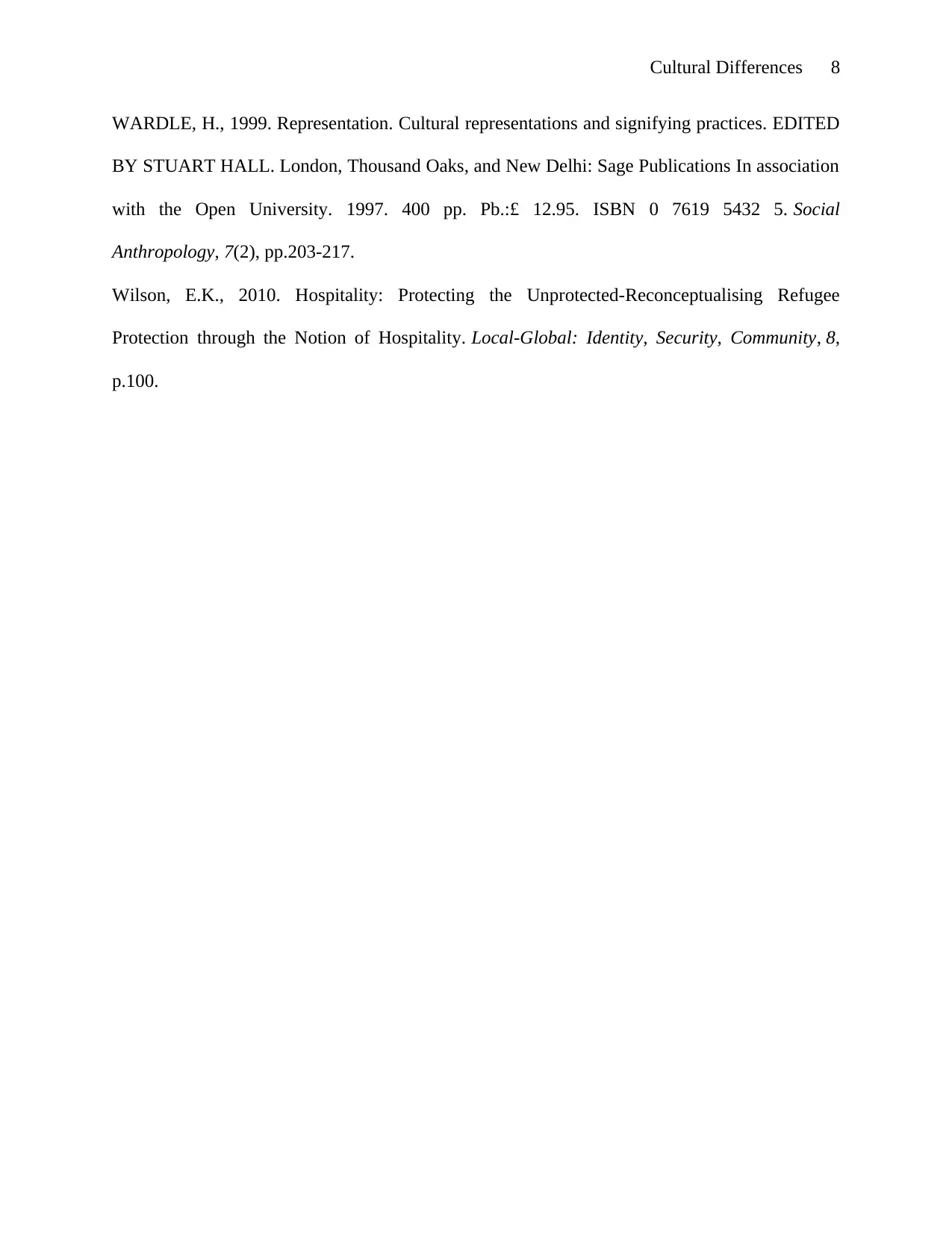
Cultural Differences 8
WARDLE, H., 1999. Representation. Cultural representations and signifying practices. EDITED
BY STUART HALL. London, Thousand Oaks, and New Delhi: Sage Publications In association
with the Open University. 1997. 400 pp. Pb.:£ 12.95. ISBN 0 7619 5432 5. Social
Anthropology, 7(2), pp.203-217.
Wilson, E.K., 2010. Hospitality: Protecting the Unprotected-Reconceptualising Refugee
Protection through the Notion of Hospitality. Local-Global: Identity, Security, Community, 8,
p.100.
WARDLE, H., 1999. Representation. Cultural representations and signifying practices. EDITED
BY STUART HALL. London, Thousand Oaks, and New Delhi: Sage Publications In association
with the Open University. 1997. 400 pp. Pb.:£ 12.95. ISBN 0 7619 5432 5. Social
Anthropology, 7(2), pp.203-217.
Wilson, E.K., 2010. Hospitality: Protecting the Unprotected-Reconceptualising Refugee
Protection through the Notion of Hospitality. Local-Global: Identity, Security, Community, 8,
p.100.
1 out of 8
Related Documents
Your All-in-One AI-Powered Toolkit for Academic Success.
+13062052269
info@desklib.com
Available 24*7 on WhatsApp / Email
![[object Object]](/_next/static/media/star-bottom.7253800d.svg)
Unlock your academic potential
Copyright © 2020–2025 A2Z Services. All Rights Reserved. Developed and managed by ZUCOL.





